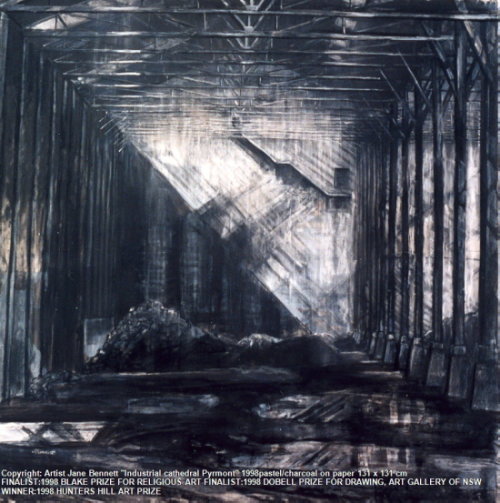 | ||
| 'Classic and Wooden Boat Show' 2010 oil on canvas 31 x 61cm $2,000 Sold Enquiries about similar paintings: janecooperbennett@gmail.com |
I started painting this 'en plein air' at the 'Classic and Wooden Boat Show' at the Australian National Maritime Museum' on Saturday 16th October despite the having to huddle up to a garbage bin to shelter from the gusts of wind.
It was more of a demonstration to help direct notice to the exhibition of marine art inside the Museum by the members of ASMA (the Australian Society of Marine Artists) than a serious attempt to produce a work of art in public.
By Sunday, however, the weather had settled down enough to actually get some paint on the canvas instead of myself and passers-by.
I had to add details like some of the flags at home, and spruce it up a bit by removing hairs and lumps of grit that had stuck to the wet paint.
I didn't have much choice of subject matter, due to the gusts of wind that threatened to send my easel cartwheeling up and down the wharf.
As I couldn't find a position to be able to paint one of the boats in all its glory, I decided to paint the atmosphere of the festival itself. This was challenging as the canvas became dotted with little unrelated vignettes as people who I had started to paint moved around.
The result was that I ended up painting mini portraits of some of the stall holders, as they moved around a bit less.
| Detail of 'Classic and Wooden Boat Show' 2010 oil on canvas 31 x 61cm 'The Boat Builders ('Denman Marine')' $2,000 Sold Enquiries about similar paintings: janecooperbennett@gmail.com |
These are 'Denman Marine'a trio of boat builders from Tasmania.
| Detail of 'Classic and Wooden Boat Show' 2010 oil on canvas 31 x 61cm 'The Musicians' $2,000 Sold Enquiries about similar paintings: janecooperbennett@gmail.com |
A trio of jazz musicians in lairy fluoro suits were milling around.
| Detail of 'Classic and Wooden Boat Show' 2010 oil painting on canvas 31 x 61cm 'Hydralign Feathering Propellers' $2,000 Sold Enquiries about similar paintings: janecooperbennett@gmail.com |
| Detail of 'Classic and Wooden Boat Show' 2010 oil on canvas 31 x 61cm 'Seatow' $2,000 Sold Enquiries about similar paintings: janecooperbennett@gmail.com |
The team from 'Seatow' demonstrated rope tricks to impress the customers.
Related posts in this blog:
- Marine Art Exhibition at the Australian National Maritime Museum (janebennettartist.blogspot.com)
- Artist in residence at Maritime Museum (janebennettartist.blogspot.com)







